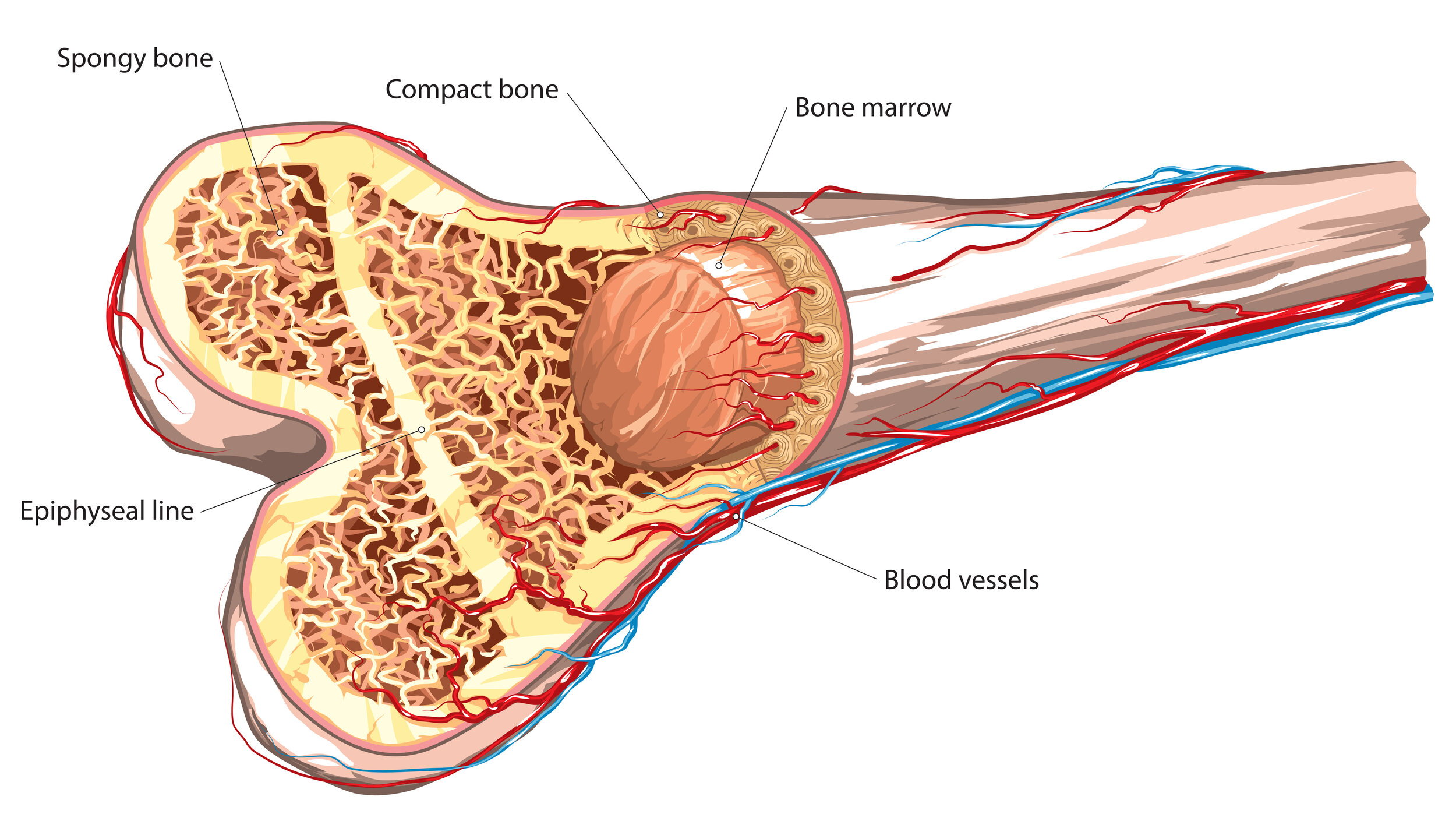Optimize Your Bone Health at Any Age
Understanding Your Bones
Your bones are often something you never think about, unless one breaks or they become compromised by osteoporosis. To understand how to prevent fractures and weak bones, especially as you get older, you first need to appreciate the structure and function of your bones.
Human bones are made up of two different types of tissue – compact bone and spongy bone. Compact bone is the dense exterior that gives bone its strength. It makes up 80% of bone in the body. Spongy bone is located inside the compact bone and consists primarily of bone marrow. Bones with a high content of spongy bone, such as vertebrae and the pelvis, are more likely to fracture because they are naturally weaker than bones with more compact bone.
Bones consist of bone cells as well as a bony matrix in which the cells live. This matrix consists of crystallized minerals primarily formed from calcium phosphate, collagen and proteoglycans. There are also two types of bone cells – osteoblasts and osteoclasts. Osteoblasts are the “bone builders,” stimulating growth of new bone. Osteoclasts are “bone carvers,” stimulating the breakdown of bone. When bones are in a healthy state the bony matrix is strong and the rate of bone formation to breakdown is equal or encouraging growth.
Healthy bones are not only important to provide shape, allow movement and protect the body. Bones are also the location of red blood cell production and mineral storage. 99% of the body’s calcium, 85% of phosphorus and 60% of magnesium are stored in bones. As the main storage for calcium, bones then also become the body’s regulator to maintain calcium levels in the blood. Calcium is critical to muscle contractions, including the heart muscle. An imbalance of calcium in the blood could lead to arrhythmia, so the body will rob the bones of calcium in order to protect the heart. Bones also assist with regulating acid-base balance in the body. The body needs to maintain a tight pH range and increased acidity in the body will stimulate release of minerals from the bones to maintain that pH. Without adequate minerals, however, bone health suffers.
Osteoporosis
Osteoporosis, literally “porous bone,” means bone density is low and bones are thin. In the medical community it is defined by a T score measured by a DEXA bone density scan. A healthy T score is greater than -1, and osteoporosis occurs if the T score is lower than -2.5. The lower the score, the more porous the bone is. Although it is normal to lose bone mass as we age, deficiencies in certain nutrients and excess consumption of certain foods and substances can increase bone loss over and above normal aging.
Nutrients for Bone Health
There are 7 nutrients and substances key for bone health – calcium, vitamin D, magnesium, vitamin C, fluoride, essential fatty acids and collagen.
Calcium. This mineral helps build strong bones because it’s used to create hydroxyapatite crystals, part of the bony matrix in compact bone. Calcium alone will not build strong bones, however. The assistance of two other nutrients – vitamin D and magnesium – is vital as well.
Vitamin D. Actually a steroid hormone that can be synthesized by the body, Vitamin D helps to regulate the metabolism of calcium and phosphorus as well as assist with calcium absorption.
Magnesium. This mineral has several important functions related to bone health. It stimulates production of a bone-building hormone called calcitonin, converts vitamin D to its active form, and assists with calcium absorption. In fact, even a mild magnesium deficiency has been linked to bone loss.
Vitamin C. This immune boosting vitamin also has several positive effects on bone. Vitamin C is required for the formation of connective tissue, which comprises 30% of bone. It also stimulates osteoblasts to encourage bone building, increases calcium absorption and enhances vitamin D’s effect on bone metabolism.
Flouride. Known to strengthen teeth enamel, fluoride also helps skeletal bone become harder, larger, and more resistant to demineralization. However, too much fluoride can weaken bones.
Essential Fatty Acids. EFAs enhance the effects of vitamin D, promote absorption of calcium, reduce excretion of calcium, increase calcium deposition in bone and aid in collagen production.
Collagen. As you can see, both vitamin C and EFAs are important for collagen production. Collagen is abundant in connective tissue and the bony matrix, both of which are important to maintaining strong bones.
Factors Affecting Bone Health
There are also several food and lifestyle choices that can negatively affect your bone health.
Excess Protein Intake – Byproducts of protein metabolism include phosphoric and sulphuric acids. The only way the body can eliminate these acids is by binding to calcium. So a high protein diet without adequate dietary mineral intake can lead to bone loss.
Imbalanced Phosphorus – In normal amounts, phosphorus is essential for bone health – combining with calcium to form a compound that gives strength and structure to bones and teeth. However, too little or too much phosphorus in relation to calcium can lead to bone loss.
High Sugar Diet – Sugar limits calcium absorption and increases excretion of calcium and other minerals out of the body. Excessive sugar consumption can then lead to bone loss.
Excessive Caffeine Intake – Similar to sugar, caffeine increases excretion of calcium as well as magnesium which can increase risk of bone loss.
Tobacco Use – Smoking not only depletes the body of vitamin C, it also increases exposure to heavy metals that get stored in bone, damaging bones.
Alcohol Consumption – Imbibing in alcohol will inhibit absorption and increase excretion of calcium, magnesium, and vitamin C – all important for bone health. Additionally, its damage to the liver can compromise vitamin D metabolism.
Digestive health is also important for bone health. Inadequate stomach acid production impairs the absorption of calcium. Additionally, impaired nutrient absorption in general will lead to reduced absorption of all nutrients key to bone health.
Hormones and Bone Health
Several hormones in the body also play an important role in bone health.
Estrogen and Testosterone both inhibit osteoclast activity, reducing breakdown of bone.
Progesterone activates osteoblasts, encouraging bone growth.
Calcitonin, a hormone released when blood calcium is too high, also inhibits breakdown of bone.
Corticosteroids, hormones released in response to stress or immune compromise, increases secretion of calcium from the bone.
When hormones are in balance, bones remain healthy. However, excessive stress and reduced hormones due to aging can both negatively affect bone health.
Fracture Risks
Weak bones due to osteoporosis is not the only risk factor for fractures. There are several independent risk factors, regardless of bone density. Physical health is a major risk factor. Specifically, the inability to rise from a chair without using your arms, lack of exercise, standing on your feet for less than 4 hours per day, poor depth perception, high resting heart rate, and hyperthyroidism. Certain medications such as anti-convulsants and tranquilizers as well as caffeine intake can also increase fracture risk. Many of these factors tie directly into your risk of falling, so taking measures to improve your balance can be an easy way to reduce your risk of fracture.
Food as Thy Medicine
Consuming foods rich in calcium, magnesium, vitamin D, vitamin C, vitamin K, and essential fatty acids as well as other minerals such as silica, zinc, copper, manganese and boron will provide the necessary nutrients for optimal bone health. Where do you find these nutrients? In whole foods! Choose organic colorful fruits and vegetables, soaked and sprouted whole grains and beans, nuts and seeds, wild caught fish, free range organic meats and dairy and cold-pressed unrefined oils for stronger healthier bones.
Resources:
Better Bones, Better Body, Susan E. Brown, PhD

